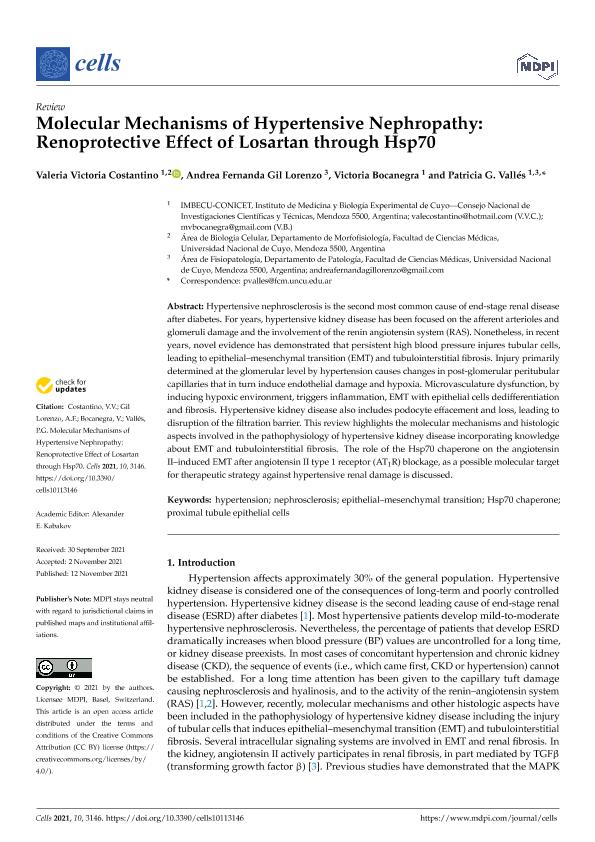Artículo
Molecular mechanisms of hypertensive nephropathy: Renoprotective effect of losartan through hsp70
Costantino, Valeria Victoria ; Gil Lorenzo, Andrea Fernanda
; Gil Lorenzo, Andrea Fernanda ; Bocanegra, María Victoria
; Bocanegra, María Victoria ; Vallés, Patricia G.
; Vallés, Patricia G.
 ; Gil Lorenzo, Andrea Fernanda
; Gil Lorenzo, Andrea Fernanda ; Bocanegra, María Victoria
; Bocanegra, María Victoria ; Vallés, Patricia G.
; Vallés, Patricia G.
Fecha de publicación:
11/2021
Editorial:
Multidisciplinary Digital Publishing Institute
Revista:
Cells
e-ISSN:
2073-4409
Idioma:
Inglés
Tipo de recurso:
Artículo publicado
Clasificación temática:
Resumen
Hypertensive nephrosclerosis is the second most common cause of end-stage renal disease after diabetes. For years, hypertensive kidney disease has been focused on the afferent arterioles and glomeruli damage and the involvement of the renin angiotensin system (RAS). Nonetheless, in recent years, novel evidence has demonstrated that persistent high blood pressure injures tubular cells, leading to epithelial–mesenchymal transition (EMT) and tubulointerstitial fibrosis. Injury primarily determined at the glomerular level by hypertension causes changes in post-glomerular peritubular capillaries that in turn induce endothelial damage and hypoxia. Microvasculature dysfunction, by inducing hypoxic environment, triggers inflammation, EMT with epithelial cells dedifferentiation and fibrosis. Hypertensive kidney disease also includes podocyte effacement and loss, leading to disruption of the filtration barrier. This review highlights the molecular mechanisms and histologic aspects involved in the pathophysiology of hypertensive kidney disease incorporating knowledge about EMT and tubulointerstitial fibrosis. The role of the Hsp70 chaperone on the angiotensin II–induced EMT after angiotensin II type 1 receptor (AT1R) blockage, as a possible molecular target for therapeutic strategy against hypertensive renal damage is discussed.
Archivos asociados
Licencia
Identificadores
Colecciones
Articulos(IMBECU)
Articulos de INST. DE MEDICINA Y BIO. EXP. DE CUYO
Articulos de INST. DE MEDICINA Y BIO. EXP. DE CUYO
Citación
Costantino, Valeria Victoria; Gil Lorenzo, Andrea Fernanda; Bocanegra, María Victoria; Vallés, Patricia G. ; Molecular mechanisms of hypertensive nephropathy: Renoprotective effect of losartan through hsp70; Multidisciplinary Digital Publishing Institute; Cells; 10; 11; 11-2021; 3146-3162
Compartir
Altmétricas



